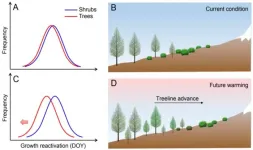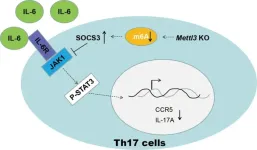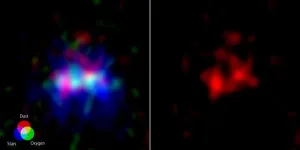(Press-News.org) Antibodies are crucial, not only for treating tumors and infections. Sometimes, however, the immune reaction they trigger can be too strong and end up causing more damage, for example in the case of people infected with Covid-19. Problems such as these can often be avoided by finetuning antibodies, as Prof. Dr. Falk Nimmerjahn from Friedrich-Alexander-Universität Erlangen-Nürnberg (FAU) and two of his colleagues in the Netherlands and in the UK have now reported in the journal Nature Immunology.
In his laboratories, the FAU researcher is carrying out research into immunoglobulin G, or IgG in short, that provides long-lasting protection against infection in the bodies of humans and animals. These biomolecules that are often used in modern medicine consist of two long and two short chains of proteins that link together to form a Y-shaped structure. For many years, research and medicine has focused on the two top branches of this Y for good reason: the two ends form a type of pocket which smaller structures on the surface of bacteria and other pathogens fit into, similarly to a key in a lock.
Key-lock principle in immune system
Just like a locksmith can produce very many different locks and the matching keys by only making a few slight changes, the immune system also produces very many different structures at the ends of immunoglobulins that match to very many different pathogens. After an infection with a specific bacterium or virus, these IgG created during the immune reaction remain on patrol within the body for a very long time and can react extremely rapidly in the case of a renewed infection.
If the key fits the lock, the immunoglobulin attaches to the pathogen and marks it for other immune specialists within the immune system. The antibody serves to mark tumor cells or pathogens to make them stand out from the huge quantities of cells and harmless microorganisms that circulate throughout the body and take on important functions in the bodies of humans and animals.
Using genetic glue to fight bacteria
Once this stage has been successfully completed, this is when the backbone of the Y-shaped IgG comes into play. It is this backbone that Falk Nimmerjahn is now investigating closely at his Chair of Genetics. Macrophages, killer cells and granulocytes take over in the end phase of the battle against an infection. “We have often observed cells working as a team, with granulocytes taking on a suicidal role;” Falk Nimmerjahn explains. Attracted by the antibody that has found its target, these cells burst, releasing their relatively sticky genetic material from their core. The bacteria that the IgG previously identified as being harmful stick to this matter.
These microorganisms can be extremely dangerous, but have now been rendered helpless, and are easy prey for the macrophages that have also been attracted and can now consume the bacteria that the antibodies have tracked down and marked. However, the macrophages are often rather aggressive and act with little consideration of possible consequences. If time is running out in the race between life and death, collateral damage is accepted as being unavoidable, and substances such as oxygen radicals and other dangerous products that would normally be rendered harmless are released. For most patients this is of no consequence: The main priority is survival, any resulting damage should be able to be repaired later.
One of the factors modulating the immune reaction involves small posttranslational modifications that are made to the backbone of the immunoglobulin after the antibody has been created. This involves, for example, little sugar molecules that are attached to the backbone of the immunoglobulin. They seem to play a crucial role in the finetuning of the immune reaction. “If the right components are missing, it makes the immune reaction much more severe,” explains Falk Nimmerjahn.
That can, however, have fatal consequences, for example if a viral infection has already severely damaged tissue. If the control mechanism on the backbone of the immunoglobulin is adjusted to only attach a little sugar and therefore induce a strong reaction, that may cause dangerously severe damage to an organ that is already stretched to its limit, such as the lung in the event of a viral infection. According to Falk Nimmerjahn, “the organism therefore adjusts its control mechanisms very exactly.” In cases such as this, the control mechanisms are set to trigger a weak reaction with many chains of sugar. Gaining an exact knowledge of this antibody tuning within the context of an immune response is fundamental if we are to improve and increase patients’ tolerance of antibodies used to treat tumors and autoimmune diseases.
END
Fintetuning for antibodies
The strength of the immune reaction triggered by antibodies can be regulated
2023-07-14
ELSE PRESS RELEASES FROM THIS DATE:
Single-end hybrid Rayleigh Brillouin and Raman distributed fibre-optic sensing system
2023-07-14
The real-time monitoring of facilities, particularly large facilities (such as rail transit systems, large bridges, and buildings), can provide information regarding their surrounding environment and allow their health conditions to be assessed, which is essential for establishing the current concept of smart cities based on the Internet of Things. As a precise real-time monitoring technique, distributed fiber-optic sensing (DFOS) systems, which require long-distance simultaneous measurements along a sensing fiber, are in high demand for various industrial applications. However, ...
Why trees outcompete shrubs to shift upward?
2023-07-14
The findings from this study, led by Professor Eryuan Liang (Institute of Tibetan Plateau Research, Chinese Academy of Sciences), were published as a research article in the journal National Science Review. The study also involved researchers from, CREAF, CSIC, Global Ecology Unit CREAF-CSIC-UAB, Instituto Pirenaico de Ecología (IPE-CSIC), Spain and Université du Québec à Chicoutimi, Canada.
Climatic warming is altering the structure and function of alpine ecosystems, including shifts of vegetation boundaries. The upward shift of alpine treelines, the uppermost limit of tree growth forming the boundary between montane forest and alpine communities, ...
New fossil flying reptile ‘Elvis’ takes flight
2023-07-14
A new 145-million-year-old pterosaur (extinct flying reptiles that lived alongside the dinosaurs) was named today by a team of British, American and German researchers. The animal was nicknamed ‘Elvis’ when the fossil was first unearthed in Bavaria, Germany because of the giant pompadour-like bony crest on its skull.
Now the animal has been given a formal scientific name of Petrodactyle wellnhoferi. The name translates as ‘Wellnhofer’s stone-finger’ honouring legendary German palaeontologist ...
m6A mRNA modification potentiates Th17 functions to inflame autoimmunity
2023-07-14
N6-methyladenosine (m6A) is the most extensive studied RNA modification across various species, and the important effect of m6A modification in immune system has been revealed in distinct contexts, including mRNA metabolism, cell differentiation, proliferation and response to stimulation. Previous studies from Hua-Bing Li group demonstrated that m6A methyltransferase METTL3 control T cells homeostasis and sustain the suppressive function of regulatory T cells (Tregs). However, the role of m6A methyltransferase in other subtype of T cells remains unknown.
T helper cells 17 ...
Exercise during dialysis has positive health impact
2023-07-14
Patients who engage in light exercise while undergoing dialysis are physically fitter and are admitted to hospital less frequently than those who do not. These are the findings of a large-scale study conducted by a consortium led by the Technical University of Munich (TUM). The researchers believe that exercise programs should be offered to dialysis patients as standard.
Around 558,000 people in the United States have such severely impaired kidney function that they require dialysis several times per week. In Germany, about 80,000 people regularly undergo ...
Link between oropharyngeal cancer and sexual behavior
2023-07-14
Human papillomavirus (HPV) is a ubiquitous virus, and most people are infected at some point in their lives. HPV can infect epithelial cells of the skin and mucosa at various sites. There are more than 100 known HPV subtypes, most of which cause only benign lesions such as warts and condyloma. Thanks to a well-functioning immune response, most people who are infected don’t develop serious symptoms. However, some HPV subtypes are not so harmless. These subtypes, and especially subtype HPV16, can transform infected cells to become neoplastic, and these malignant transformed cells then develop into precancerous ...
Scientists use Insilico Medicine’s generative AI platform to predict drug targets for rare lysosomal storage disease
2023-07-14
A team led by researchers at the Mechanisms of Inherited Kidney Disorders (MIKADO) group at the University of Zurich (Zurich, Switzerland) has used Insilico Medicine’s generative artificial intelligence (AI) target discovery engine, PandaOmics, to identify actionable drug targets for the lysosomal storage disease cystinosis and to validate them in preclinical models of the disease. These results, which open new therapeutic possibilities for this devastating disease, were published June 14 in the journal Nature Communications. Collaborators include scientists from Microsoft Research-University of Trento Centre for Computational ...
Lipid test can reveal risk of preeclampsia, a potentially deadly pregnancy complication
2023-07-14
University of Virginia School of Medicine researchers have discovered a way to identify pregnant women at risk of preeclampsia, a serious disorder characterized by high blood pressure and kidney dysfunction which can result in premature delivery, seizures and even death. Complications from the condition are the second-leading cause of maternal death around the world.
The UVA scientists, led by Charles E. Chalfant, PhD, found that they could predict the risk of preeclampsia by examining lipids (fats) ...
Stellar cradles and graves seen in farthest galaxy ever
2023-07-14
New observations using the Atacama Large Millimeter/submillimeter Array (ALMA) have distinguished the sites of star formation and a possible site of star death from the surrounding nebula in a galaxy 13.2 billion light-years away. This is the farthest that such structures have been observed.
A team led by Yoichi Tamura, an astronomer at Nagoya University, attempted high-resolution observations of MACS0416_Y1, located 13.2 billion light-years away in the constellation Eridanus. Previous observations of this galaxy by the same team had detected radio waves emitted by both oxygen and dust, two components of interstellar nebulae. Detailed observations of the ...
Liquid crystals that mimic beetle shell coloration units used to create more secure type of QR code
2023-07-14
A research group led by Dr. Jialei He of Nagoya University's Graduate School of Engineering has developed a method for processing cholesteric liquid crystals (CLCs) into micrometer-sized spherical particles. CLCs are a type of liquid crystal that possess a helical structure, giving them unique optical properties and the ability to selectively reflect light. By combining spherical CLC particles with commercially available pigments, the researchers developed a unique anti-counterfeiting QR code that can only be displayed under a specific circular polarizer. The results were published in the journal Advanced Optical Materials.
CLCs are an example of how nature can be ...
LAST 30 PRESS RELEASES:
Discovery on how aggressive breast cancer controls protein production
A simple blood test can predict Crohn’s disease years before symptoms appear
FAU study reveals social, family and health factors behind teen bullying
New alliance trial seeks to reduce delays in gastrointestinal cancer treatment
Discovery of a new superfluid phase in non-Hermitian quantum systems
Codes in the cilia: New study maps how Cilk1 and Hedgehog levels sculpt tooth architecture
Chonnam National University researchers develop novel virtual sensor grid method for low-cost, yet robust, infrastructure monitoring
Expanded school-based program linked to lower youth tobacco use rates in California
TV depictions of Hands-Only CPR are often misleading
What TV gets wrong about CPR—and why it matters for saving lives
New study: How weight loss benefits the health of your fat tissue
Astronomers surprised by mysterious shock wave around dead star
‘Death by a thousand cuts’: Young galaxy ran out of fuel as black hole choked off supplies
Glow with the flow: Implanted 'living skin' lights up to signal health changes
Compressed data technique enables pangenomics at scale
How brain waves shape our sense of self
Whole-genome sequencing may optimize PARP inhibitor use
Like alcohol units, but for cannabis – experts define safer limits
DNA testing of colorectal polyps improves insight into hereditary risks
Researchers uncover axonal protein synthesis defect in ALS
Why are men more likely to develop multiple myeloma than women?
Smartphone-based interventions show promise for reducing alcohol and cannabis use: New research
How do health care professionals determine eligibility for MAiD?
Microplastics detected in rural woodland
JULAC and Taylor & Francis sign open access agreement to boost the impact of Hong Kong research
Protecting older male athletes’ heart health
KAIST proposes AI-driven strategy to solve long-standing mystery of gene function
Eye for trouble: Automated counting for chromosome issues under the microscope
The vast majority of US rivers lack any protections from human activities, new research finds
Ultrasound-responsive in situ antigen "nanocatchers" open a new paradigm for personalized tumor immunotherapy
[Press-News.org] Fintetuning for antibodiesThe strength of the immune reaction triggered by antibodies can be regulated





